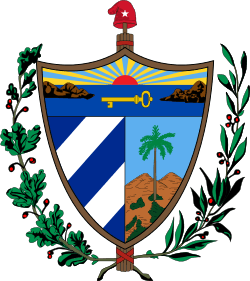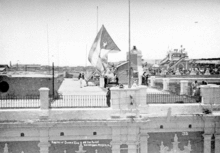Republic of Cuba (1902–59)
| Republic of Cuba | ||||||||||||||
| República de Cuba | ||||||||||||||
| ||||||||||||||
| ||||||||||||||
| Anthem La Bayamesa "The Bayamo Song" | ||||||||||||||
.svg.png) | ||||||||||||||
| Capital | Havana | |||||||||||||
| Languages | Spanish | |||||||||||||
| Religion | Roman Catholic | |||||||||||||
| Government | 1902–1940: Unitary presidential republic 1940–1959: Authoritarian semi-presidential republic | |||||||||||||
| President | ||||||||||||||
| • | 1902–1906 | Tomás Estrada Palma (first) | ||||||||||||
| • | 1952–1959 | Fulgencio Batista (last) | ||||||||||||
| Prime Minister | ||||||||||||||
| • | 1940–1942 | Carlos Saladrigas Zayas (first) | ||||||||||||
| • | 1959 | José Miró Cardona (last) | ||||||||||||
| Legislature | Congress | |||||||||||||
| • | Upper Chamber | Senate | ||||||||||||
| • | Lower Chamber | House of Representatives | ||||||||||||
| Historical era | Modern Era | |||||||||||||
| • | Platt Amendment | 2 March 1901 | ||||||||||||
| • | Constitution adopted | 20 May 1902 | ||||||||||||
| • | Treaty of Relations | 17 February 1903 | ||||||||||||
| • | Treaty of Relations | 29 May 1934 | ||||||||||||
| • | Cuban Revolution | 1 January 1959 | ||||||||||||
| Currency | Cuban peso | |||||||||||||
| ||||||||||||||
| Today part of | | |||||||||||||
Part of a series on the |
|---|
| History of Cuba |
 |
| Governorate of Cuba (1511–1519) |
| Viceroyalty of New Spain (1535–1821) |
| Captaincy General of Cuba (1607–1898) |
| US Military Government (1898–1902) |
| Republic of Cuba (1902–1959) |
|
| Republic of Cuba (1959–) |
| Timeline |
|
|
| Topical |
|
|
The Republic of Cuba (Spanish: República de Cuba) of 1902 to 1959, refers to the historical period in Cuba from 1902, when Cuba seceded from US rule in the aftermath of the Spanish–American War that took Cuba from Spanish rule in 1898, until the Cuban Revolution of 1959. Cuban independence from the United States was guaranteed in the Platt Amendment proposed to the United States Congress in 1901.[1] It was officially a representative democracy though at times it became controlled by a military junta. The Cuban Revolution of 1959 massively changed Cuban society, creating a socialist state and ended US economic dominance in Cuba.
Cuba during this time has been regarded as a client state of the United States.[2] In 1934, Cuba and the United States signed the Treaty of Relations in which Cuba was obligated to give preferential treatment of its economy to the United States, in exchange the United States gave Cuba a guaranteed 22 percent share of the US sugar market that later was amended to a 49 percent share in 1949.[3]
Early independent governments

After the Spanish–American War, Spain and the United States signed the Treaty of Paris (1898), by which Spain ceded Puerto Rico, the Philippines, and Guam to the United States for the sum of $20 million.[4] Cuba gained formal independence from the U.S. on May 20, 1902, as the Republic of Cuba.[5] Under Cuba's new constitution, the U.S. retained the right to intervene in Cuban affairs and to supervise its finances and foreign relations. Under the Platt Amendment, the U.S. leased the Guantánamo Bay naval base from Cuba.
Following disputed elections in 1906, the first president, Tomás Estrada Palma, faced an armed revolt by veterans of the war for independence who defeated the government's meager forces.[6] The U.S. intervened by occupying Cuba and named Charles Edward Magoon as Governor for three years. Cuban historians have attributed Magoon's governorship as having introduced political and social corruption.[7] In 1908, self-government was restored when José Miguel Gómez was elected President, but the U.S. continued intervening in Cuban affairs. In 1912, the Partido Independiente de Color attempted to establish a separate black republic in Oriente Province,[8] but was suppressed by General Monteagudo with considerable bloodshed.
In 1924, Gerardo Machado was elected president. During his administration, tourism increased markedly, and American-owned hotels and restaurants were built to accommodate the influx of tourists. The tourist boom led to increases in gambling and prostitution.[9] The Wall Street Crash of 1929 led to precipitous drops in the price of sugar, political unrest, and repression.[10] Protesting students, known as the Generation of 1930, turned to violence in opposition to the increasingly unpopular Machado.[10] A general strike (in which the Communist Party sided with Machado),[11] uprisings among sugar workers, and an army revolt forced Machado into exile in August 1933. He was replaced by Carlos Manuel de Céspedes y Quesada.[10]
Revolution of 1933

In September 1933, the Sergeants' Revolt, led by Sergeant Fulgencio Batista, overthrew Cespedes.[12] General Alberto Herrera served briefly as president (August 12–13) followed by Carlos Manuel de Céspedes y Quesada from August 13 until September 5, 1933. A five-member executive committee (the Pentarchy of 1933) was chosen to head a provisional government.[13] They were ousted by a student-led organization, the Student Directory and Ramon Grau San Martin was then appointed as provisional president.[13] Grau resigned in 1934, after which Batista dominated Cuban politics for the next 25 years, at first through a series of puppet-presidents.[12] The period from 1933 to 1937 was a time of "virtually unremitting social and political warfare".[14]
Constitution of 1940
A new constitution was adopted in 1940, which engineered radical progressive ideas, including the right to labor and health care.[15] Batista was elected president in the same year, holding the post until 1944.[16] He is so far the only non-white Cuban to win the nation's highest political office.[17][18][19] His government carried out major social reforms. Several members of the Communist Party held office under his administration.[20] Cuban armed forces were not greatly involved in combat during World War II, although president Batista suggested a joint U.S.-Latin American assault on Francoist Spain in order to overthrow its authoritarian regime.[21]
Batista adhered to the 1940 constitution's strictures preventing his re-election.[22] Ramon Grau San Martin was the winner of the next election, in 1944.[16] Grau further corroded the base of the already teetering legitimacy of the Cuban political system, in particular by undermining the deeply flawed, though not entirely ineffectual, Congress and Supreme Court.[23] Carlos Prío Socarrás, a protégé of Grau, became president in 1948.[16] The two terms of the Auténtico Party saw an influx of investment which fueled a boom and raised living standards for all segments of society and created a prosperous middle class in most urban areas.
Batista coup

After running unsuccessfully for the presidency in 1952, Batista staged a coup.[24] He outlawed the Cuban Communist Party in 1952.[25] Cuba had Latin America's highest per capita consumption rates of meat, vegetables, cereals, automobiles, telephones and radios, though about one third of the population was considered poor and enjoyed relatively little of this consumption.[26]
In 1958, Cuba was a relatively well-advanced country by Latin American standards, and in some cases by world standards.[27] On the other hand, Cuba was affected by perhaps the largest labor union privileges in Latin America, including bans on dismissals and mechanization. They were obtained in large measure "at the cost of the unemployed and the peasants", leading to disparities.[28] Between 1933 and 1958, Cuba extended economic regulations enormously, causing economic problems.[17][29] Unemployment became a problem as graduates entering the workforce could not find jobs.[17] The middle class, which was comparable to that of the United States, became increasingly dissatisfied with unemployment and political persecution. The labor unions supported Batista until the very end.[17][18] Batista stayed in power until he was forced into exile in December 1958.[24]
References
- ↑ Pérez, Louis A. (1991). Cuba Under the Platt Amendment, 1902–1934. Pittsburgh, PA: Pittsburgh University Press. p. 54.
- ↑ Pérez, Louis A. (1991). Cuba Under the Platt Amendment, 1902–1934. Pittsburgh, PA: Pittsburgh University Press. p. xvi.
- ↑ Miller, John; Kenedi, Aaron (2003). Inside Cuba: The History, Culture, and Politics of an Outlaw Nation. New York: Marlowe & Company. pp. 35–36.
- ↑ "Treaty of Peace Between the United States and Spain". The Avalon Project. Yale Law School. December 10, 1898.
- ↑ Louis A. Pérez (1998). Cuba Between Empires: 1878–1902. University of Pittsburgh Pre. p. xv. ISBN 978-0-8229-7197-9. Retrieved July 19, 2013.
- ↑ Diaz-Briquets, Sergio; Pérez-López, Jorge F. (2006). Corruption in Cuba: Castro and Beyond. Austin: University of Texas Press. p. 63. ISBN 0-292-71321-5. Retrieved September 6, 2009.
- ↑ Thomas, Hugh (1998). Cuba or the Pursuit of Freedom. pp. 283–287. ISBN 978-0-306-80827-2.
- ↑ Beede, Benjamin, ed. (1994). The War of 1898, and U.S. interventions, 1898–1934: an encyclopedia. New York: Garland. p. 134. ISBN 0-8240-5624-8. Retrieved September 6, 2009.
- ↑ Terry K Sanderlin, Ed D (April 24, 2012). The Last American Rebel in Cuba. AuthorHouse. p. 7. ISBN 978-1-4685-9430-0. Retrieved July 19, 2013.
- 1 2 3 Wilber Albert Chaffee; Gary Prevost (1992). Cuba: A Different America. Rowman & Littlefield. p. 4. ISBN 978-0-8476-7694-1. Retrieved July 19, 2013.
- ↑ Argote-Freyre, Frank (2006). Fulgencio Batista. 1. New Brunswick, NJ: Rutgers University Press. p. 50. ISBN 0-8135-3701-0.
- 1 2 Jones, Melanie (2001). Jacqueline West, ed. South America, Central America and the Caribbean 2002. Routledge. p. 303. ISBN 978-1-85743-121-6. Retrieved July 19, 2013.
- 1 2 Jaime Suchlicki (2002). Cuba: From Columbus to Castro and Beyond. Potomac Books, Inc. p. 95. ISBN 978-1-57488-436-4. Retrieved July 19, 2013.
- ↑ Domínguez, Jorge I. Cuba: Order and Revolution. Cambridge, MA: Harvard University Press. p. 76.
- ↑ Domínguez, Jorge I. Cuba: Order and Revolution. Cambridge, MA: Harvard University Press. p. ?.
- 1 2 3 Frank R. Villafana (December 31, 2011). Expansionism: Its Effects on Cuba's Independence. Transaction Publishers. p. 201. ISBN 978-1-4128-4656-1. Retrieved July 19, 2013.
- 1 2 3 4 Horowitz, Irving Louis, ed. (1998) [1988]. Cuban Communism (6 ed.). Transition Books. p. 662.
- 1 2 Bethell, Leslie (1993). Cuba. Cambridge University Press. ISBN 978-0-521-43682-3.
- ↑ Sweig, Julia E. (2004). Inside the Cuban Revolution: Fidel Castro and the Urban Underground. Cambridge, MA: Harvard University Press. p. 4.
- ↑ Sweig, Julia E. (2004). Inside the Cuban Revolution: Fidel Castro and the Urban Underground. Cambridge, MA: Harvard University Press. p. ?.
- ↑ "Batista's Boot". Time. January 18, 1943. Retrieved April 20, 2013.
- ↑ Domínguez, Jorge I. Cuba: Order and Revolution. Cambridge, MA: Harvard University Press. p. 101.
- ↑ Domínguez, Jorge I. Cuba: Order and Revolution. Cambridge, MA: Harvard University Press. pp. 110–11.
- 1 2 Maureen Ihrie; Salvador Oropesa (October 31, 2011). World Literature in Spanish: An Encyclopedia: An Encyclopedia. ABC-CLIO. p. 262. ISBN 978-0-313-08083-8. Retrieved July 19, 2013.
- ↑ Sweig, Julia E. (2004). Inside the Cuban Revolution: Fidel Castro and the Urban Underground. Cambridge, MA: Harvard University Press. p. 6.
- ↑ Paul H. Lewis (2006). Authoritarian Regimes in Latin America. Oxford, UK: Rowman & Littlefield. p. 186. ISBN 0-7425-3739-0. Retrieved September 14, 2009.
- ↑ Smith & Llorens 1998.
- ↑ Baklanoff 1998.
- ↑ Thomas, Hugh (1998). Cuba or the Pursuit of Freedom. p. 1173. ISBN 978-0-306-80827-2.
